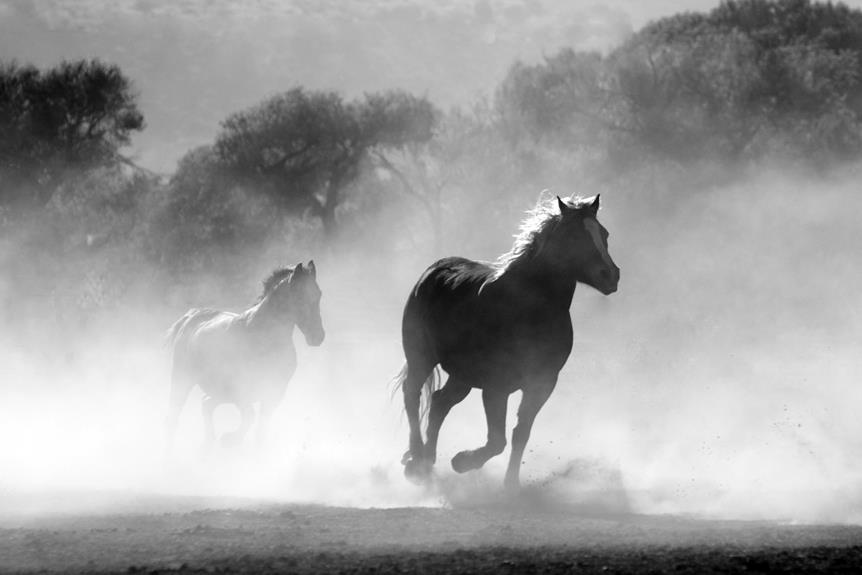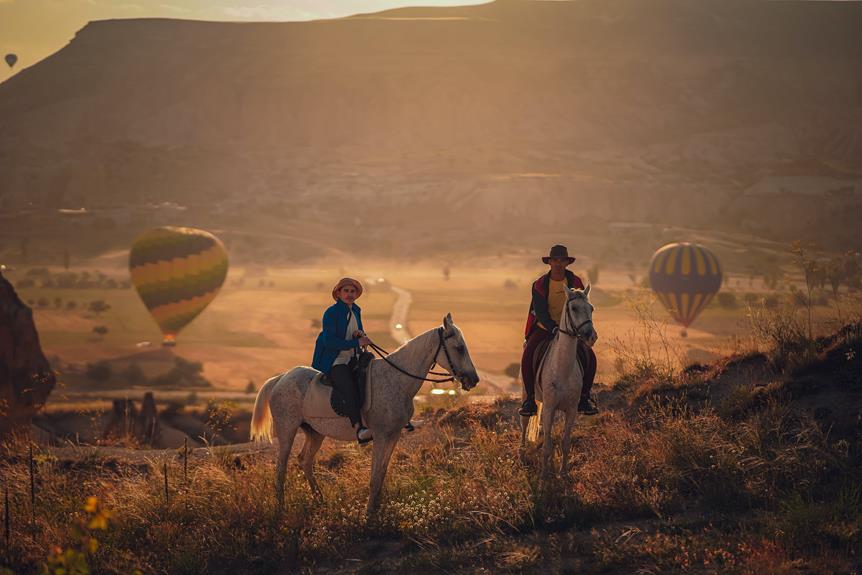Do you know what a wild horse is called?
You might be surprised to learn that a wild horse is commonly referred to as a mustang.
These majestic creatures, descendants of once-domesticated horses, roam freely across the vast landscapes of the Western United States.
But there is more to the story than just a name.
In this discussion, we will explore the history of America's wild horses, the challenges they face, and the controversies surrounding their management and conservation.
So, saddle up and join us as we uncover the fascinating world of the mustang.
Key Takeaways
- Mustangs are wild horses descended from Colonial Spanish horses and are native to North America.
- The Bureau of Land Management (BLM) manages and protects wild horses in the United States.
- There are controversies surrounding the status of wild horses as introduced invasive species or native to the land.
- Wild Horse Conservation Efforts, such as Wild Horse Education, aim to protect the rights and welfare of wild horses and address management issues on public lands.
Mustang
Mustangs, descended from Colonial Spanish horses, are free-roaming horses native to North America, specifically the Western United States. These wild horses, once domesticated, have now become feral herds that roam across public lands. The Bureau of Land Management (BLM) is responsible for managing and protecting America's wild horses, including the mustangs. They do this through the creation of Herd Management Areas, which are designated areas where the horses can freely roam.
These mustangs are a unique part of the American landscape, symbolizing the spirit of the wild and the untamed. Unlike domestic horses, they've adapted to life in the wild, thriving in rugged terrain and harsh conditions. Their distinctive phenotypes reflect the contributions of various breeds and types of horses over time.
However, the management of mustang population numbers is a contentious issue. Critics argue that they're an introduced invasive species, while advocates believe they're native to the United States. Additionally, conflicts arise over the sharing of land and resources between mustangs and livestock.
Wild Horse Education (WHE) is an organization dedicated to advocating for public lands and public horses. They strive to educate the public about the difference between truly wild horses, like mustangs, and feral horses. Through litigation, they address issues related to the protection and preservation of these majestic creatures.
Wild Horse Education
As we shift our focus to the subtopic of Wild Horse Education, let's explore an organization that advocates for public lands and public horses through education and litigation.
Wild Horse Education (WHE) is dedicated to educating the public about America's wild horses and their populations, as well as addressing issues related to their management on public lands.
Here is a breakdown of what Wild Horse Education does:
- Education: WHE aims to educate the public about the difference between wild and feral horses. They provide information on the history and importance of wild horses as a reintroduced native species. By raising awareness, they hope to foster a better understanding of the unique challenges faced by wild horse populations.
- Litigation: WHE utilizes litigation as a tool to address concerns surrounding wild horses in public lands. They tackle issues such as welfare ranching and livestock trespass on the range. Through legal action, they strive to protect the rights and welfare of wild horses and burros.
Przewalski's Horse
Przewalski's Horse, the last remaining truly wild horse, is critically endangered and found in Mongolia. This unique horse, distinct from domesticated horses, is a testament to the resilience and beauty of wild horses. Przewalski's Horse diverged from a common ancestor around 500,000 years ago and is the only wild horse left in the world.
Due to its critically endangered status, conservation efforts are crucial to protect Przewalski's Horse. Reintroduction sites in Mongolia, China, and Kazakhstan have been established to help increase the population of this remarkable species. The horse thrives in the largely unaltered grasslands of the Mongolian steppe, which provides an ideal habitat for its survival.
In the context of wild horses, it's important to note that Przewalski's Horse is distinct from the free-roaming horses and burros found in the Americas. The management of these free-roaming horses and burros falls under the jurisdiction of the United States government, specifically the Bureau of Land Management (BLM) and the Forest Service. The Wild Free-Roaming Horse and Burro Act, passed in 1971, provides guidelines for the protection and management of these animals on federal lands.
History of America's Wild Horses
The history of America's wild horses dates back to the arrival of the Spanish in the Americas. The term 'mustang' likely comes from the Spanish words 'mestengo' and 'mostrenco,' which referred to livestock without a master. These horses are descendants of the Colonial Spanish horses and are renowned for their varying phenotypes and surefootedness. Native to the North American continent, mustangs are free-roaming horses of the Western United States, brought to the Americas by the Spanish. They embody the historic and pioneer spirit of the American West.
The management levels of wild populations have been a topic of concern. The U.S. Bureau of Land Management (BLM) takes charge of managing and protecting the mustang population. They utilize methods such as rounding up excess horses and offering them for adoption. However, there have been concerns about potential sales for horse meat.
Wild Horse Annie was a prominent figure in the preservation of wild horses. She played a crucial role in advocating for the protection of these native animals.
Land Use Controversies
Land use controversies surrounding wild horses involve debates over the sharing of land and resources between mustangs and livestock, as well as the management methods used to control mustang population numbers. These debates often center around whether wild horses are an introduced invasive species or native to the land. The ranching industry and the Bureau of Land Management (BLM) are often involved in these controversies.
One of the key arguments in these debates is whether wild horses, in general, are native or introduced species. This has led to the need for comparative statistics and education on public land grazing. The BLM's management methods, including rounding up excess horses and offering them for adoption, have sparked concerns about the treatment and fate of the horses, as well as the shortage of adopters.
Controversies also arise from the conditions during roundups and the distinction between wild and feral horses. Some argue that only horses that have been domesticated and then returned to the wild are truly feral, while others maintain that all free-roaming horses are wild. This debate creates a need for education and advocacy for public lands and the management of wild horse populations.
Frequently Asked Questions
What Is the Name of a Wild Horse?
A wild horse is called a mustang. They are descendants of once-domesticated horses and roam freely in North America. The U.S. Bureau of Land Management manages their population, but controversies surround their management and conservation.
What Is the True Wild Horse Called?
The true wild horse, called a mustang, has a rich history in North America. Conservation efforts aim to protect their unique genetic diversity, while challenges like habitat loss and domestication threaten their survival.
What Is the Term Wild Horses?
Wild horses are free-roaming, undomesticated horses that live in the wild. They differ from feral horses, as they are descendants of once-domesticated horses. They adapt to their habitat and face challenges from human activities. Conservation efforts aim to protect these iconic creatures.
What Is a Untamed Horse Called?
An untamed horse is called a mustang. Capturing techniques and training methods are used to tame them. The behavior of untamed equines can be challenging, but conservation efforts aim to protect their natural habitats and genetic diversity. Mustangs have a significant role in American culture.
Conclusion
So, now you know that a wild horse is called a mustang. These free-roaming horses are descendants of once-domesticated horses and are now considered feral.
The U.S. Bureau of Land Management manages their population, but controversy surrounds their management and the sharing of land with livestock.
Despite the challenges, mustangs continue to roam the Western United States, reminding us of the untamed beauty of the wild.



0 Comments